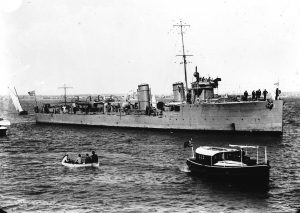- Author
- Gillett, Ross
- Subjects
- History - general, Ship design and development, Ship histories and stories
- Tags
-
- RAN Ships
- None noted.
- Publication
- June 2011 edition of the Naval Historical Review (all rights reserved)
We gratefully acknowledge the following article which is taken from the author’s new book “Australia’s Fighting Ships”, published in April 2011 by Topmill Pty Ltd.
On 10 July 2011 the Royal Australian Navy (RAN) of the 21st century celebrates the centennial of the granting of its ‘Royal’ prefix by King George V in the United Kingdom. The decision was promulgated to the Commonwealth Naval Forces (CNF) on 5 October 1911 when the former CNF officially became the Royal Australian Navy, with the Royal Navy’s White Ensign replacing the former Blue Ensign and the Union flag replaced by the Commonwealth (national) flag at the bow.
With its proper title and appearance now settled, the new Fleet’s first big public day occurred on Saturday morning, 4 October 1913, when the city of Sydney came to a complete standstill for the first ever RAN fleet entry. For their arrival, His Majesty’s Australian Ships Australia and Sydney avoided the other major ports, sailing via Jervis Bay to rendezvous with the rest of the available fleet – the two cruisers and three destroyers. After a short period of ‘spit and polish’ the fleet proceeded on their final leg of the voyage into Sydney Harbour. The battlecruiser led her consorts into Sydney Harbour for the first time, including the cruisers Sydney, Melbourne and Encounter and the trio of torpedo boat destroyers Warrego, Parramatta and Yarra. Their arrival at Garden Island was what many contemporary media described as the most powerful naval force in the southern hemisphere. The entry was a symbolic event, as several units of the new fleet had been operating in Australian waters since 1910-12, although the ceremonial arrival was the first occasion all had joined together as the one group.

Graeme Andrews
Following the entrance of the new fleet, another chapter of local naval history also drew to a close. The Commander-in-Chief of the Royal Navy’s Australian Squadron, Admiral Sir George King-Hall, struck his flag in the cruiser HMS Cambrian the same day. The next fleet units to arrive at Garden Island in Sydney were the submarines AE1 and AE2 during May 1914. The Fleet was now ready and able to meet the expected challenge from an enemy at sea.

Big Guns
The mere presence of the battlecruiser armed with eight 12 inch and sixteen 4 inch guns and her high speed of 25 knots was the deterrent needed to protect the new nation from enemy naval forces and the raiders that would seek to disrupt merchant shipping and other maritime activities. For her time Australia was a massive improvement over the old Royal Navy flagships of the Australia Station, her armament was vastly superior and she could catch an enemy lurking in the nation’s home waters. The even older colonial gunboats could not match her in any way. She was the ‘star’ of the new Navy, armed ‘to the teeth’, a member of the ‘new’ navy of the type being created for the Royal Navy.
At 21,300 tons full load, Australia out-displaced nine of the older third class cruisers like Pioneer or three of the second class cruisers such as Encounter. She was manned by over 820 personnel and could steam for over 6,300 nautical miles before the need to re-coal her vast bunkers. Australia was the eighth British-built battlecruiser to enter service, after the initial three ship “Invincible” class and as the third member of the three strong “Indefatigable” class. Upon the outbreak of the Great War, Australia and her escorts were urgently despatched to the nearest problem spot, German New Guinea, to perform many important tasks. The enemy squadron led by Von Spee, had no alternative but to avoid the Australian ships at all cost. Then when her role in the Pacific and north of Australia was over the battlecruiser sailed to England to join the Grand Fleet, as flagship of the Second Battlecruiser Squadron.
In a post-war statement wartime Prime Minister Billy Hughes commented, “the great cities of Australia would have been reduced to ruins, coastwise shipping sunk and communications with the outside world cut off”, but for the presence of the RAN. Despite the above and much other public sentiment about her disposal, Australia’s first flagship was removed from the active fleet in December 1921 as a result of naval cutbacks. Sadly she had to be scuttled off Sydney on 12 April 1924, under the terms of the Washington Naval Treaty to reduce overall battleship and battlecruiser numbers.
Early Naval Aviation
Australian involvement in naval aviation has spanned an impressive 94 years. It had its roots in the years 1917-19 when the battlecruiser Australia and the light cruisers Sydney, Melbourne and Brisbane operated primitive bi-planes for reconnaissance missions, the battlecruiser with two Sopwith aircraft and the cruisers one each.




